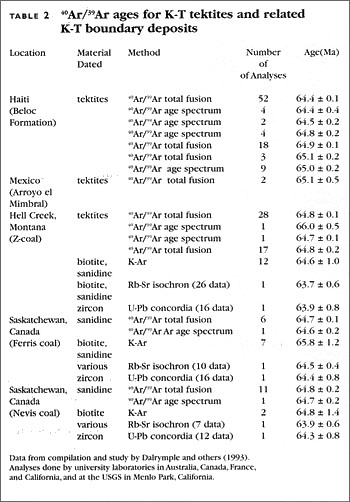They
are justified in discarding data because contamination is known to be abundant. This establishes the scenario where any unfavorable data can be rejected. There's nothing wrong with this in itself, but it's when old-earth believers begin pushing "
concordance of dating data" as irrefutable proof of its validity that we find an obvious problem.
For example, we are shown snazzy little diagrams like this one posted earlier.
This is
gospel to old-earth believers. They look at those numbers and marvel at how agreeable the dates are and are beside themselves that anyone would question it.
The problem is that nobody tells you how much discordant data was filtered out to produce those results. We are looking at data, only after it has passed through a sieve, i.e. the confirmation bias of the scientist. The concordance is an illusion because the discordance is masked.
Well all right then, here's your big chance to make your point. What data was erroneously filtered out, and why? Please cite your claims from the paper, "40Ar/39Ar age spectra and total-fusion ages of tektites from Cretaceous-Tertiary boundary sedimentary rocks in the Beloc Formation, Haiti" that the graph was lifted from.
I even found you a working link to the full text of the paper!
I mean, you're making this accusation that dates were rejected
because they didn't fit, rather than because of evidence of contamination or methodological errors. These are
big accusations -
career-ending accusations. Andrew Wakefield lost his medical license over one such intentional fudging. I assume this means you've read the paper this graph is based on and can point out where this happened. Because, you know, otherwise, you're just making stuff up about scientific research you haven't even read, and defaming a scientist baselessly. That'd be kinda bad.
Ironically, look how many in this thread whine about "quote-mining" and "taking things out of context", yet for all the years they've been bandying about popular compilations of old-earth "dates", they themselves have never been presenting the data in its full context.
Dude, you know how I know this graph isn't some kind of out-of-context quote mine? Because the guy presenting it
is the lead author. And the data itself was published in peer review. And, you know, you can
read the paper. Something I don't think you've done or plan to do.
I don't know why you think you can just say whatever you want about research that you clearly haven't read and don't understand. Newsflash, we're
skeptics. We
check things.

When you say something like "this quote proves that an incredibly useful, widely-used and universally-accepted tool is untrustworthy", we're gonna ask for the context. When you say "this study filtered out data in order to come to its intended conclusion", we're gonna ask you to
prove it. And when you refuse to even answer the most basic of questions in order to support your opinion... Well, I dunno. What should we take from that?
(By the way, did you ever read that Forster/Warrington paper you quoted from? It's a simple yes or no question, man, how come you haven't given an answer yet?)


